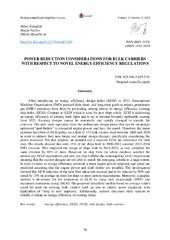Приказ основних података о документу
Power reduction considerations for bulk carriers with respect to novel energy efficiency regulations
| dc.creator | Kalajdžić, Milan | |
| dc.creator | Vasilev, Matija | |
| dc.creator | Momčilović, Nikola | |
| dc.date.accessioned | 2022-09-19T19:26:13Z | |
| dc.date.available | 2022-09-19T19:26:13Z | |
| dc.date.issued | 2022 | |
| dc.identifier.issn | 0007-215X | |
| dc.identifier.uri | https://machinery.mas.bg.ac.rs/handle/123456789/3684 | |
| dc.description.abstract | After introducing an energy efficiency design index (EEDI) in 2011, International Maritime Organization (IMO) pursued their short- and long-term goals to reduce greenhouse gas (GHG) emissions from ships by presenting, among others, an energy efficiency existing ship index (EEXI). Contrary to EEDI which is used for new ships solely, EEXI is addressing an energy efficiency of already built ships and is set to become formally applicable starting from 2023. Existing designs cannot be essentially and rapidly changed to comply the criterion. The only main particular from the preliminary design phase that can be meaningly optimized ???post festum??? is a required engine power, and thus, the speed. Therefore, the paper explores the effect of EEXI policy on a fleet of 153 bulk carriers built between 2000 and 2020 in order to address their near future and prompt design changes, specifically considering the power reduction. For that purpose, an attained and a required EEXI are calculated for each ship. The results showed that only 15% of the ships built in 2000-2012 satisfied 2013-2014 IMO criterion. This impacted the design of ships built in 2013-2022, as they complied the same criterion by 88% of share. However, no ship from the whole database satisfied the present day EEDI requirement and only one ship fulfilled the contemporary EEXI requirement meaning that the current designs are not able to match the emerging criteria to a large extent. In order to meet an energy efficiency criterion, a main engine power reduction and speed are predicted assuming that the engine power and shaft limiter are installed. The investigation showed that MCR reduction of the total fleet taken into account had to be reduced by 50% and speed by 15% on average in order for ships to meet current requirements. Moreover, a graphic method is developed for the estimation of EEXI by using only deadweight (DWT) and could be used on existing bulk carriers with an aim to satisfy novel regulation with reliably evaluate an energy efficiency of existing ships. | en |
| dc.publisher | Univ Zagreb Fac Mechanical Engineering & Naval Architecture, Zagreb | |
| dc.relation | info:eu-repo/grantAgreement/MESTD/inst-2020/200105/RS// | |
| dc.rights | openAccess | |
| dc.rights.uri | https://creativecommons.org/licenses/by/4.0/ | |
| dc.source | Brodogradnja | |
| dc.subject | ship design | en |
| dc.subject | energy efficiency | en |
| dc.subject | EEXI | en |
| dc.subject | EEDI | en |
| dc.subject | bulk carriers | en |
| dc.title | Power reduction considerations for bulk carriers with respect to novel energy efficiency regulations | en |
| dc.type | article | |
| dc.rights.license | BY | |
| dc.citation.epage | 92 | |
| dc.citation.issue | 2 | |
| dc.citation.other | 73(2): 79-92 | |
| dc.citation.rank | M23~ | |
| dc.citation.spage | 79 | |
| dc.citation.volume | 73 | |
| dc.identifier.doi | 10.21278/brod73205 | |
| dc.identifier.fulltext | http://machinery.mas.bg.ac.rs/bitstream/id/2231/3681.pdf | |
| dc.identifier.scopus | 2-s2.0-85132931464 | |
| dc.identifier.wos | 000822958900002 | |
| dc.type.version | publishedVersion |


